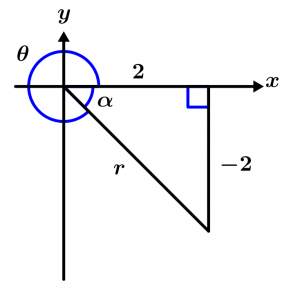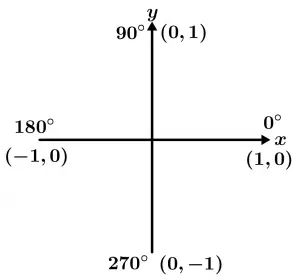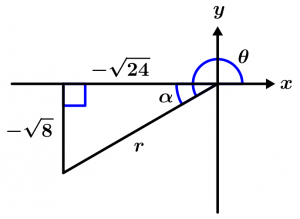Next we will explain the fundamental operations with complex numbers such as addition, subtraction, multiplication, division, potentiation and roots, it will be as explicit as possible and we will even include examples of operations with complex numbers. Before we start, remember that the value of i = \sqrt {-1}
Sum of complex numbers
To add complex numbers, all the real parts are added and separately all the imaginary parts are added.
Example of sum of complex numbers
(2 + 3i)+(4 - 7i)
Let’s remove the parentheses
2 + 3i + 4 - 7i
And now let’s add the real numbers and the imaginary numbers
2 + 4 + 3i - 7i = 6 - 4i
Subtraction of complex numbers
To subtract complex numbers, all the real parts are subtracted and all the imaginary parts are subtracted separately.
Example of subtraction of complex numbers
(2 + 3i)-(4 - 7i)
Let’s remove the parentheses
2 + 3i - 4 + 7i
And now let’s add the real numbers and the imaginary numbers
2 - 4 + 3i + 7i = -2 + 10i
Multiplication of complex numbers
The product of complex numbers is obtained multiplying as common binomials, the subsequent operations after reducing terms will depend on the exponent to which i is found.
Example of the product of complex numbers
(2 + 3i)(4 - 7i)
We proceed to make the multiplication step by step:
2(4) - 2(7i) + 4(3i) - (3i)(7i)
8 - 14i + 12i - 21i^{2}
Now, we will reduce similar terms, we will sum the terms of i:
8 - 2i - 21i^{2}
Remember the value of i = \sqrt{-1}, we can say that i^{2}=\left(\sqrt{-1}\right)^{2}=-1, so let’s replace that term:
8 - 2i - 21(-1) = 8 - 2i + 21
Finally we will obtain that the product of the complex number is:
29 - 2i
Division of complex numbers
To perform the division of complex numbers, you have to use rationalization because what you want is to eliminate the imaginary numbers that are in the denominator because it is not practical or correct that there are complex numbers in the denominator.
Example of the division of complex numbers
\cfrac{2 + 3i}{4 - 7i}
To rationalize we are going to multiply the fraction by another fraction of the denominator conjugate, observe the following:
\cfrac{2 + 3i}{4 - 7i} \cdot \cfrac{4 + 7i}{4 + 7i}
It is observed that in the denominator we have conjugated binomials, so we proceed step by step to carry out the operations both in the denominator and in the numerator:
\cfrac{2 + 3i}{4 - 7i} \cdot \cfrac{4 + 7i}{4 + 7i} = \cfrac{2(4) + 2(7i) + 4(3i) + (3i)(7i)}{(4)^{2} - (7i)^{2}}
\cfrac{8 + 14i + 12i + 21i^{2}}{16 - 49i^{2}}
Remember that the value of i^{2}=\left(\sqrt{-1}\right)^{2}=-1, so let’s proceed to replace that term in the i^{2} the fraction that we are solving and reduce terms:
\cfrac{8 + 26i + 21(-1)}{16 - 49(-1)}= \cfrac{8 + 26i - 21}{16 + 49}
\cfrac{8 - 21 + 26i}{65} = \cfrac{-13 + 26i}{65}
As a final step we can separate the fraction:
\cfrac{-13}{65} + \cfrac{26}{65}i
= \cfrac{-1}{5} + \cfrac{2}{5} i
Powers of complex numbers
There is a very powerful theorem of imaginary numbers that will save us a lot of work, we must take it into account because it is quite useful, it says:
The product module of two complex numbers is equal to the product of its modules and the argument of the product is equal to the sum of the arguments.
Now, with the theorem very clear, if we have two equal complex numbers, its product is given by the following relation:
\left( x + yi \right)^{2} = \left[r\left( \cos \theta + i \sin \theta \right) \right]^{2} = r^{2} \left( \cos 2 \theta + i \sin 2 \theta \right)
\left(x + yi \right)^{3} = \left[r\left( \cos \theta + i \sin \theta \right) \right]^{3} = r^{3} \left( \cos 3 \theta + i \sin 3 \theta \right)
\left(x + yi \right)^{4} = \left[r\left( \cos \theta + i \sin \theta \right) \right]^{4} = r^{4} \left( \cos 4 \theta + i \sin 4 \theta \right)
Regardless of the exponent you have, it is always going to be fulfilled, which results in the following theorem, which is better known as De Moivre’s Theorem:
\left( x + yi \right)^{n} = \left[r\left( \cos \theta + i \sin \theta \right) \right]^{n} = r^{n} \left( \cos n \theta + i \sin n \theta \right)
Example of the power of complex numbers
Reduce the next complex number \left(2 - 2i\right)^{10}, it is recommended that you first graph it.

In order to solve the complex number, the first thing we have to do is find its module and its argument, we will find its module first:
x = 2 \qquad y = -2
Remembering that r=\sqrt{x^{2}+y^{2}} we have the following:
r = \sqrt{(2)^{2} + (-2)^{2}} = \sqrt{4 + 4} = \sqrt{8}
r = 2\sqrt{2}
Now let’s calculate the argument of our complex number:
Remembering that \tan\alpha=\cfrac{y}{x} we have the following:
\tan \alpha = \cfrac{-2}{2}
At the moment we can ignore the sign, and then we will accommodate it with respect to the quadrant where it is:
\tan \alpha = \cfrac{2}{2} = 1
\alpha = \tan^{-1}(1) = 45°
It should be noted that the angle found with the inverse tangent is only the angle of elevation of the module measured from the shortest angle on the axis x, the angle \theta has a value between 0°\le \theta \le 360° and in this case the angle \theta has a value of 360°-\alpha=315°.
So once we have the argument and the module, we can proceed to substitute De Moivre’s Theorem equation:
\left[r\left( \cos \theta + i \sin \theta \right) \right]^{n} =
\left(2\sqrt{2} \right)^{10}\left[ \cos 10(315°) + i \sin 10 (315°) \right]
We proceed to raise to ten to 2\sqrt{2} and multiply 10(315°):
32768\left[ \cos 3150° + i \sin 3150°\right]
Now, how do we solve the trigonometric functions with that 3150° angle? From here there is a concept that I like to use, which is the number of turns making a simple rule of 3. For those very large angles, the value we get in the rule of 3 will remove the entire part and we will only keep the decimals to find the angle. Look, if 1\ \text{turn} equals 360°, how many turns v equals 3150°?
\begin{array}{c c c}
1 \ \text{turn} & \ \Rightarrow \ & 360° \\
v & \ \Rightarrow \ & 3150°
\end{array}Now doing our simple rule of 3, we will obtain the following:
v = \cfrac{3150(1)}{360} = \cfrac{35}{4} = 8.75
So 3150° equals 8.75 turns, now we have to remove the integer part and re-do a rule of 3. If a turn equals 360°, how many degrees g_{1} equals 0.75 turns ?
\begin{array}{c c c}
1 \ \text{turn} & \ \Rightarrow \ & 360° \\
0.75 & \ \Rightarrow \ & g_{1}
\end{array}By performing our rule of 3 we will obtain the following:
g_{1} = \cfrac{0.75(360°)}{1} = 270°
Great, with this new angle value found we can proceed to replace it, we will change 3150° with 270° which is exactly the same when applying sine and cosine:
32768\left[ \cos 270° + i \sin 270° \right]
See figure 2:

Note the angle of 270 ° is in one of the axes, the value of these “hypotenuses” is of the value of 1, because it is assumed that the “3 sides” of the “triangle” measure the same because those 3 sides “are” on the same axis of 270°). Now, this makes it clear that \sin=\frac{y}{h} and that \cos \frac{x}{h} and that what we see in Figure 2 in the angle of 270° is that the coordinate it has is (0,-1), which means that the value of x is zero and that the value of y is -1, so:
\sin 270° = \cfrac{y}{h} \qquad \cos 270° = \cfrac{x}{h}
\sin 270° = \cfrac{-1}{1} = -1 \qquad \cos 270° = \cfrac{0}{1}
\sin 270° = -1 \qquad \cos 270° = 0
Once we have these values found, we can proceed to continue:
32768\left[ \cos 270 + i \sin 270 \right] = 32768 \left[0 + i (-1) \right]
32768 \left[ -i\right]
Now we only carry out one last multiplication to obtain that:
-32768i
So our complex number of \left(2-2i\right)^{10} developed equals -32768i!
Roots of complex numbers
To have total control of the roots of complex numbers, I highly recommend consulting the book of Algebra by the author Charles H. Lehmann in the section of “Powers and roots”.
But I’ll leave you a summary below, you’ll need the following theorem that comes in that same section, it says something like this:
Every number (except zero), real or complex, has exactly n different nth roots.
If the module and the argument of any number are represented by r and \theta, respectively, then the n roots are given by the expression:
r^{\frac{1}{n}} \left[ \cos \cfrac{\theta + k \cdot 360°}{n} + i \sin \cfrac{\theta + k \cdot 360°}{n} \right]
And if you ask to calculate the fourth roots, the four roots or the roots n=4, k has to go from the value 0 to 3, that means that the value of k will go from zero to n-1.
Example of the roots of complex numbers
Find the n=5 roots of \left(-\sqrt{24}-\sqrt{8} i\right)
x = -\sqrt{24} \qquad y = -\sqrt{8}

Note: In these examples of roots of imaginary numbers it is advisable to use a calculator to optimize the time of calculations.
To proceed with the resolution, first we have to find the polar form of our complex number, we calculate the module:
r = \sqrt{x^{2} + y^{2}} = \sqrt{(-\sqrt{24})^{2} + (-\sqrt{8})^{2}}
r = \sqrt{32} = 4\sqrt{2}
Now we must calculate the argument, first calculate the angle of elevation that the module has ignoring the signs of x and y:
\tan \alpha = \cfrac{y}{x} = \cfrac{\sqrt{8}}{\sqrt{24}}
\alpha = \tan^{-1}\cfrac{\sqrt{8}}{\sqrt{24}} = 30°
With the value of \alpha we can already know the value of the argument that is \theta=180°+\alpha=210°
Great, now that we have the argument, we can substitute terms in the formula seen in the theorem of this section:
r^{\frac{1}{n}} \left[ \cos \cfrac{\theta + k \cdot 360°}{n} + i \sin \cfrac{\theta + k \cdot 360°}{n} \right] =
\left( \sqrt{32} \right)^{\frac{1}{5}} \left[ \cos \cfrac{210° + k \cdot 360°}{5} + i \sin \cfrac{210° + k \cdot 360°}{5} \right]=
\left( \sqrt{2} \right) \left[ \cos \cfrac{210° + k \cdot 360°}{5} + i \sin \cfrac{210° + k \cdot 360°}{5} \right]
Just need to substitute k for 0,1,2,3 and 4, I recommend you use the calculator and remember to place it in DEGREES, you must see a D above enclosed in a square \fbox{D} in your calculator, so our 5 roots are the following:
k=0\left( \sqrt{2} \right) \left[ \cos \cfrac{210° + 0 \cdot 360°}{5} + i \sin \cfrac{210° + 0 \cdot 360°}{5} \right]=
\left( \sqrt{2} \right) \left[ \cos \cfrac{210°}{5} + i \sin \cfrac{210°}{5} \right]=
\left( \sqrt{2} \right) \left[ \cos 42° + i \sin 42° \right]=
\left( \sqrt{2} \right) \left[ 0.74 + i 0.67 \right]
0.74\sqrt{2} + 0.67\sqrt{2}i
k=1\left( \sqrt{2} \right) \left[ \cos \cfrac{210° + 1 \cdot 360°}{5} + i \sin \cfrac{210° + 1 \cdot 360°}{5} \right]=
\left( \sqrt{2} \right) \left[ \cos \cfrac{210° + 360°}{5} + i \sin \cfrac{210° + 360°}{5} \right]=
\left( \sqrt{2} \right) \left[ \cos \cfrac{570°}{5} + i \sin \cfrac{570°}{5} \right]=
\left( \sqrt{2} \right) \left[ \cos 114° + i \sin 114° \right]=
\left( \sqrt{2} \right) \left[ -0.40 + 0.91i \right]=
-0.40\sqrt{2} + 0.91\sqrt{2}i
k=2\left( \sqrt{2} \right) \left[ \cos \cfrac{210° + 2 \cdot 360°}{5} + i \sin \cfrac{210° + 2 \cdot 360°}{5} \right]=
\left( \sqrt{2} \right) \left[ \cos \cfrac{210° + 720°}{5} + i \sin \cfrac{210° + 720°}{5} \right]=
\left( \sqrt{2} \right) \left[ \cos \cfrac{930°}{5} + i \sin \cfrac{930°}{5} \right]=
\left( \sqrt{2} \right) \left[ \cos 186° + i \sin 186° \right]=
\left( \sqrt{2} \right) \left[ -0.99 - 0.10i \right]=
-0.99\sqrt{2} - 0.10\sqrt{2}i
k=3\left( \sqrt{2} \right) \left[ \cos \cfrac{210° + 3 \cdot 360°}{5} + i \sin \cfrac{210° + 3 \cdot 360°}{5} \right]=
\left( \sqrt{2} \right) \left[ \cos \cfrac{210° + 1080°}{5} + i \sin \cfrac{210° + 1080°}{5} \right]=
\left( \sqrt{2} \right) \left[ \cos \cfrac{1290°}{5} + i \sin \cfrac{1290°}{5} \right]=
\left( \sqrt{2} \right) \left[ \cos 258° + i \sin 258° \right]=
\left( \sqrt{2} \right) \left[ -0.20 - 0.97i \right]=
-0.20\sqrt{2} - 0.97\sqrt{2}i
k=4\left( \sqrt{2} \right) \left[ \cos \cfrac{210° + 4 \cdot 360°}{5} + i \sin \cfrac{210° + 4 \cdot 360°}{5} \right]=
\left( \sqrt{2} \right) \left[ \cos \cfrac{210° + 1440°}{5} + i \sin \cfrac{210° + 1440°}{5} \right]=
\left( \sqrt{2} \right) \left[ \cos \cfrac{1650°}{5} + i \sin \cfrac{1650°}{5} \right]=
\left( \sqrt{2} \right) \left[ \cos 330° + i \sin 330° \right]=
\left( \sqrt{2} \right) \left[ \cfrac{\sqrt{3}}{2} - \cfrac{1}{2}i \right]=
\cfrac{\sqrt{3}}{2}\sqrt{2} - \cfrac{1}{2}\sqrt{2}i
\cfrac{\sqrt{6}}{2} - \cfrac{\sqrt{2}}{2}i
Thank you for being at this moment with us :)
